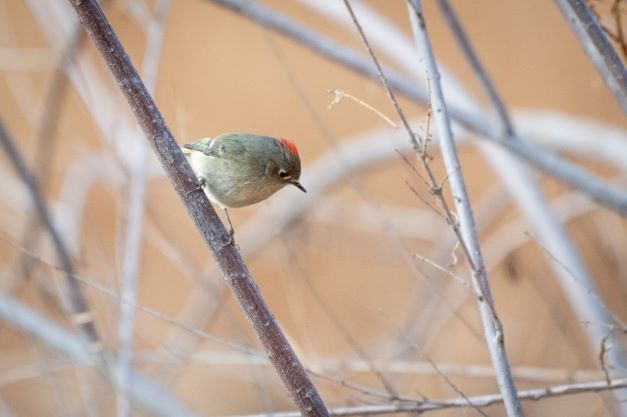
- This event has passed.
The Ruby-crowned Kinglet
February 28, 2022 @ 8:00 am - 5:00 pm

WHICH “GRAY BIRD” BEHAVES LIKE IT’S HAD TOO MUCH CAFFEINE?”
Birders often say that “little gray birds” are notoriously hard to identify (especially without binoculars), but it is even more difficult when the bird is an acrobat in constant motion – the eye just won’t focus quickly enough to see who you’re dealing with! The ruby-crowned kinglet (Regulus calendula) is such a bird. At just over four inches long, this small, quick-moving bird is hard to identify unless it happens to be a male and he happens to be agitated or excited and is showing his fiery red crest!
Ruby-crowned kinglets are common in lowland areas like Clark County Wetlands Park in the winter, but the spring migration finds them on their way to their colder breeding range in coniferous forests from the mountains of the western United States north into Alaska and Canada. There, the tiny birds nest and raise their young among the spruce and fir trees.
Biologists have described the ruby-crowned kinglet as a “fussbudget without rival,” “hyperactive,” and a “worrywart.” Kinglets have a jerky, undulating flight style. When perched, they continually flick their wings open and closed, hop from branch to branch, twist and turn, chatter, and generally seem to be endlessly “bustling” around among the branches.
All that activity does have a purpose. Ruby-crowns eat mainly insects and other small invertebrates they pluck from the outer foliage of trees and shrubs. They will jump up from a perch, fluttering their wings to reach a prime gleaning spot, or hover in front of leaf clusters and snap insects right out of the air. They occasionally supplement their diet with some fruits and seeds, and they enjoy drinking tree sap. They often join mixed foraging flocks of other “gray birds” like titmice, nuthatches, creepers, and warblers in the winter, making them even harder to pick out and identify. At my backyard watering place they often show up to drink in the company of white-crowned sparrows and dark-eyed juncos.
Active birds the size of ruby-crowned kinglets have very high metabolic rates. David Allen Sibley has written that kinglets have a resting heartrate over 600 beats a minute, which doubles to over 1200 beats a minute when the bird is active. They routinely lose 10% of their body weight just sleeping overnight and gain it back the next day. Closely related golden-crowned kinglets wintering in the far north actually need to eat the equivalent of at least 27 large pizzas per day! How’s THAT for eating “like a bird?”
If your eye catches flicking wings and constant motion in the branches along a Wetlands Park trail, stop and raise your binoculars. A closer look may reveal a “little gray bird” with a red Mohawk head stripe, very visible pale eye-ring, wide dark eyes, and a black bar below the white bar on its wings – if it will hold still long enough for you to see!
Please enjoy these YouTube videos!
Ruby-crowned Kinglet – Tiny Bird with a big Song
www.youtube.com/watch?v=EYCEiDXgEM
Fast-moving Ruby-crowned Kinglet
www.youtube.com/watch?v=vMPYW8ejw4c
Ruby-crowned Kinglet feeding
www.youtube.com/watch?v=BDaEoeZaRLO
– By Chris Leavitt, President; photo by David Walker.
